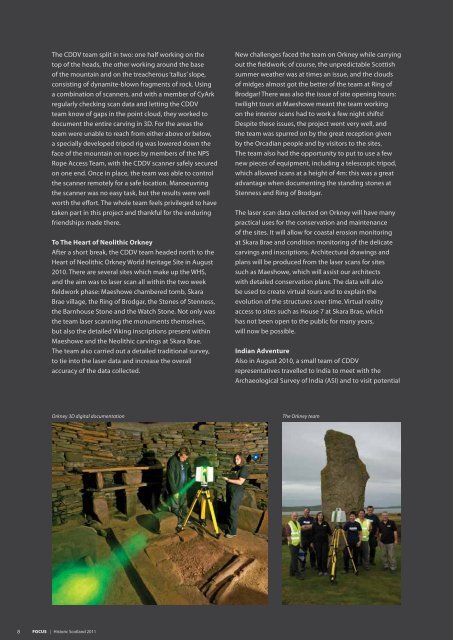informing the conservation of the built env ironment - Historic Scotland
informing the conservation of the built env ironment - Historic Scotland
informing the conservation of the built env ironment - Historic Scotland
Create successful ePaper yourself
Turn your PDF publications into a flip-book with our unique Google optimized e-Paper software.
The CDDV team split in two: one half working on <strong>the</strong><br />
top <strong>of</strong> <strong>the</strong> heads, <strong>the</strong> o<strong>the</strong>r working around <strong>the</strong> base<br />
<strong>of</strong> <strong>the</strong> mountain and on <strong>the</strong> treacherous ‘tallus’ slope,<br />
consisting <strong>of</strong> dynamite-blown fragments <strong>of</strong> rock. Using<br />
a combination <strong>of</strong> scanners, and with a member <strong>of</strong> CyArk<br />
regularly checking scan data and letting <strong>the</strong> CDDV<br />
team know <strong>of</strong> gaps in <strong>the</strong> point cloud, <strong>the</strong>y worked to<br />
document <strong>the</strong> entire carving in 3D. For <strong>the</strong> areas <strong>the</strong><br />
team were unable to reach from ei<strong>the</strong>r above or below,<br />
a specially developed tripod rig was lowered down <strong>the</strong><br />
face <strong>of</strong> <strong>the</strong> mountain on ropes by members <strong>of</strong> <strong>the</strong> NPS<br />
Rope Access Team, with <strong>the</strong> CDDV scanner safely secured<br />
on one end. Once in place, <strong>the</strong> team was able to control<br />
<strong>the</strong> scanner remotely for a safe location. Manoeuvring<br />
<strong>the</strong> scanner was no easy task, but <strong>the</strong> results were well<br />
worth <strong>the</strong> effort. The whole team feels privileged to have<br />
taken part in this project and thankful for <strong>the</strong> enduring<br />
friendships made <strong>the</strong>re.<br />
To The Heart <strong>of</strong> Neolithic Orkney<br />
After a short break, <strong>the</strong> CDDV team headed north to <strong>the</strong><br />
Heart <strong>of</strong> Neolithic Orkney World Heritage Site in August<br />
2010. There are several sites which make up <strong>the</strong> WHS,<br />
and <strong>the</strong> aim was to laser scan all within <strong>the</strong> two week<br />
fieldwork phase: Maeshowe chambered tomb, Skara<br />
Brae village, <strong>the</strong> Ring <strong>of</strong> Brodgar, <strong>the</strong> Stones <strong>of</strong> Stenness,<br />
<strong>the</strong> Barnhouse Stone and <strong>the</strong> Watch Stone. Not only was<br />
<strong>the</strong> team laser scanning <strong>the</strong> monuments <strong>the</strong>mselves,<br />
but also <strong>the</strong> detailed Viking inscriptions present within<br />
Maeshowe and <strong>the</strong> Neolithic carvings at Skara Brae.<br />
The team also carried out a detailed traditional survey,<br />
to tie into <strong>the</strong> laser data and increase <strong>the</strong> overall<br />
accuracy <strong>of</strong> <strong>the</strong> data collected.<br />
New challenges faced <strong>the</strong> team on Orkney while carrying<br />
out <strong>the</strong> fieldwork; <strong>of</strong> course, <strong>the</strong> unpredictable Scottish<br />
summer wea<strong>the</strong>r was at times an issue, and <strong>the</strong> clouds<br />
<strong>of</strong> midges almost got <strong>the</strong> better <strong>of</strong> <strong>the</strong> team at Ring <strong>of</strong><br />
Brodgar! There was also <strong>the</strong> issue <strong>of</strong> site opening hours:<br />
twilight tours at Maeshowe meant <strong>the</strong> team working<br />
on <strong>the</strong> interior scans had to work a few night shifts!<br />
Despite <strong>the</strong>se issues, <strong>the</strong> project went very well, and<br />
<strong>the</strong> team was spurred on by <strong>the</strong> great reception given<br />
by <strong>the</strong> Orcadian people and by visitors to <strong>the</strong> sites.<br />
The team also had <strong>the</strong> opportunity to put to use a few<br />
new pieces <strong>of</strong> equipment, including a telescopic tripod,<br />
which allowed scans at a height <strong>of</strong> 4m: this was a great<br />
advantage when documenting <strong>the</strong> standing stones at<br />
Stenness and Ring <strong>of</strong> Brodgar.<br />
The laser scan data collected on Orkney will have many<br />
practical uses for <strong>the</strong> <strong>conservation</strong> and maintenance<br />
<strong>of</strong> <strong>the</strong> sites. It will allow for coastal erosion monitoring<br />
at Skara Brae and condition monitoring <strong>of</strong> <strong>the</strong> delicate<br />
carvings and inscriptions. Architectural drawings and<br />
plans will be produced from <strong>the</strong> laser scans for sites<br />
such as Maeshowe, which will assist our architects<br />
with detailed <strong>conservation</strong> plans. The data will also<br />
be used to create virtual tours and to explain <strong>the</strong><br />
evolution <strong>of</strong> <strong>the</strong> structures over time. Virtual reality<br />
access to sites such as House 7 at Skara Brae, which<br />
has not been open to <strong>the</strong> public for many years,<br />
will now be possible.<br />
Indian Adventure<br />
Also in August 2010, a small team <strong>of</strong> CDDV<br />
representatives travelled to India to meet with <strong>the</strong><br />
Archaeological Survey <strong>of</strong> India (ASI) and to visit potential<br />
Orkney 3D digital documentation<br />
The Orkney team<br />
8 FOCUS | <strong>Historic</strong> <strong>Scotland</strong> 2011











![Elgin Cathedral Wedding Brochure [pdf, 544kb] - Historic Scotland](https://img.yumpu.com/22301571/1/190x151/elgin-cathedral-wedding-brochure-pdf-544kb-historic-scotland.jpg?quality=85)




